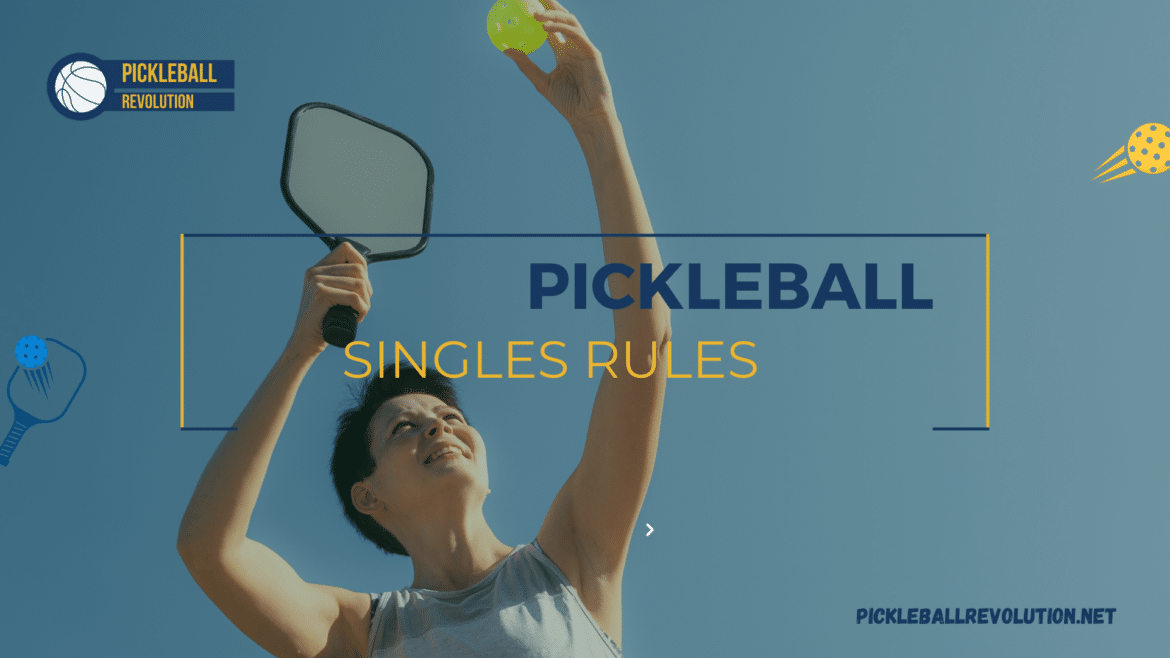Table of Contents
Ready to play some singles game and dominate the court? Let do some pickleball actions! As a pickleball player, you must like the idea of playing a doubles and singles pickleball game. However, do you usually tend to ignore the rules for some reason? But, let’s break it to you; if you love the game of pickleball you have got to understand some rules properly. Therefore, first you need to know all the pickleball singles rules. Now, if you must be wondering what a singles game is; two players compete against one another on opposing sides of the court in singles pickleball. Their goal is to score points to hit the ball over the net and into the other player’s court in a fashion that prevents them from returning it. If you want to expand your horizons and play skinny singles, you don’t have to search any further. Let us look closely what exactly the pickleball singles are.
What is a Singles Game?
You all must know how popular of a game pickleball has become in recent years. Whether its the singles or the doubles. Now coming back to the singles, the fundamental rules of the game, which cover serving, scoring, determining faults, and court setup, are identical to those for doubles play. But in singles play, players cover the whole court independently, making for a more physically demanding game that requires sprints and fast reactions, much like tennis. After every point, players have to switch sides, and the serving team’s score determines the serving rotation. Pickleball in singles demands accurate shots and intelligent placement to outplay the opposition and win without the support of a partner. Let us learn about skinny singles now.

Skinny Singles Pickleball Rules
In pickleball, skinny singles are a modified game variation that combines doubles and singles play characteristics. To provide a tighter playing space, the playing court is divided in half, either along the centerline or using the diagonal service courts. This adjustment seeks to preserve the competitive one-on-one element of singles play while simplifying the process of covering ground.
- Court Coverage: Players only cover half the court, similar to doubles play.
- Playing Area: Focuses on a smaller area compared to traditional singles, making it easier to handle.
- Serving Rules: Follows regular singles serving rules; a player serves until a mistake causes a side out.
- Competition: Not commonly played in official competitions but is great for relaxed play or training.
- Skill Practice: Allows players to practice specific skills in a controlled environment.
- Game Flexibility: Blends elements of doubles and singles play for a fun, adaptable experience on the court.
An Overview of Pickleball Court for Singles
The typical pickleball court, which is 20 feet wide and 44 feet long, is used for singles pickleball. The center of the court is separated into two halves by a 34-inch-tall net. There are additional service courts in each half of the court, with a right-hand and a left-hand service court for every player.
Pickleball Singles Serve Rules
There are regulations for serving in singles pickleball that are intended to keep the game balanced and fair. Each player’s first serve is made from the right side of the court to start the match. This regulation gives both players a starting point and guarantees consistency.
- After winning the first serve, the server moves to the left side of the court for their subsequent serve.
- Every successful serve results in a switch of sides, which prevents any player from unfairly benefiting from court positioning.
- Until they make a mistake, the serving player keeps switching between the right and left sides of the court.
- A serve is a fault when it misses the net, does not land in the opponent’s service court, or breaks any other serving regulation.
- The receiving player receives the serve after a fault, at which point they take the serve for the subsequent point.

Singles Pickleball Scoring
In singles pickleball, scoring is determined by the serving position and follows a simple pattern.
- The score is equal when the server begins from the right side of the court.
- On the other hand, the score is odd if the server moves to the left.
- Thanks to this alternating pattern, the score is kept clear and consistent throughout the game.
Play and Planning
Singles pickleball aims to outmaneuver your opponent by positioning shots intelligently and taking advantage of their weaknesses.
- The no-volley zone kitchen is located seven feet out from the net on alternate sides of the court and should be observed by players, much like in doubles play.
- The players must cover the court quickly to return strokes and anticipate their opponent’s movements.
- This requires precise footwork and posture. Agility and fast responses are essential for success in singles play.
- Players should also vary their shots to keep their opponent off balance, using a combination of drives, lobs, drops, and spins.
- By using a variety of shots in their game, players can keep up the pressure and create mistakes from their opponents.
Getting the Score Right
In singles pickleball, it’s critical to communicate the score clearly to prevent misunderstandings and arguments.
- To ensure that both players know the current score, players should announce the score loudly and before each serve.
- Accurately calling the score promotes a courteous and sportsmanlike environment on the court.
- When looking for a solitary challenge on the pickleball court, singles pickleball offers a dynamic and exciting experience.
- By learning the rules and strategies of solo play, players can improve their skills and enjoy competitive matches against opponents of similar ability.
With the right technique, movement, and strategy, players can thrive in singles pickleball and feel the rush of success on the court.

The Guide to Scoring and Faults
Players must know the scoring and mistakes to guarantee fair and accurate play in singles pickleball. Let’s look at the guidelines for singles pickleball scoring and faults.
- Points to Win: At the end of a singles pickleball match, a player needs to score 11 points in total.
- Winning Margin: Nevertheless, scoring 11 points is insufficient. Additionally, the victorious player needs to hold an advantage over their rival of at least two points, which guarantees a decisive victory.
- Points for the Serving Player: Points are only awarded to the serving player. Instead of gaining a point for winning a rally, the receiving team gains the opportunity to serve next.
- Serving Rotation: A player’s score determines which side of the court they serve from. If their score is equal, the server serves from the right side. If not, they serve from the left. This rotation helps players stay on top of their scores during furious rallies.
- Erroneous Score Alignment: An error occurs when the score is not aligned with the serving side. For example, it is a fault if the serving player serves from the left-hand side and their score is even.
- Consequence of Fault: When a player or a team commits a fault, the player serving forfeits the serve and gives the opposition a chance to serve next and score points. This guarantees that mistakes in the scoring are quickly corrected, preserving the game’s fairness.
Recognizing these regulations guarantees that participants may efficiently monitor the score and uphold the values of equitable play in singles pickleball. Additionally, it emphasizes how crucial accuracy and focus are to serving and scoring.
Common Faults While Playing Singles
- Servings land in the kitchen, which is not the volley zone.
- Volleying too soon is a violation of the Two-Bounce Rule.
- Not serving underhand within waist-level bounds.
- Serving incorrectly, traveling out of bounds, or failing to cross the net.
- Unable to maintain control of shot direction and force, giving opponents easy points.

Difference between Pickleball Singles Rules and Pickleball Doubles Game
Although pickleball’s fundamental gameplay is similar to singles and doubles matches, the rules differ.
Serving Order and Points
First, let us see what is the difference between the serving order and points.
- Singles: In singles pickleball rules, each player gets one serve; a mistake results in a forfeited service. You use the numbers for scoring, with the server’s scores being awarded first, followed by the opponents’ scores.
- Doubles: In a doubles match, each player on each side serves once. This implies that each player serves once before the ball moves on to the next player on the team. Three numbers are used in scoring to keep track of the score and help determine which team is serving.
Size of Court
Next, we have the side of the court comparison for pickleball singles rules and the doubles.
- Singles: Compared to doubles, singles play on a narrower court, which allows for a more deliberate and methodical style of play.
- Doubles: To accommodate more players, doubles matches are on a normal pickleball court, which is broader. You can also analyze the side & construction properly with the help of USA Pickleball.
Serve Guidelines
Lastly, we have the serve guidelines for the singles and doubles game.
- Singles: In a singles match, the serve has to traverse the court diagonally and land on the opponent’s service court. If this isn’t the case, there is an error.
- Doubles: Each team member gets a turn serving consecutively before switching to the next player. The same diagonal rule determines the serve in doubles as in singles.
Players must comprehend these distinctions to perform well in singles and doubles matches. Gaining control over these small details, like serving sequence management and court size adaptation, will improve your pickleball game tremendously.

Final Thoughts
Summing up, understanding the subtleties of singles play takes pickleball to a new level in the dynamic game. Singles pickleball requires skill and accuracy from shot placement to court coverage flexibility. Comprehending the regulations regulating singles play, regardless of experience level, is critical. Every element, from scoring to serving rules, adds to the game’s rhythm. Maintaining fair play and sportsmanship requires announcing the score, switching teams, and making mistakes. As we discussed above, the volley zone line transforms into a battlefield for tactical exchanges where every hit matters as players move across the court.
In conclusion, the regulations are the guiding principles that guarantee an exciting and equitable game of pickleball, both singles and doubles. Enter the court, accept the challenge, and get a firsthand look at the thrill of slim singles play. Enjoy your pickleball singles game.
LETS HIT THOSE SINGLES WELL & FINE!




